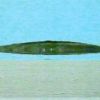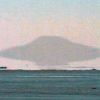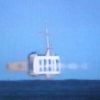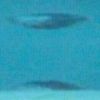When light rays travel through air layers with different temperatures – and therefore also with different densities and different refractive indices – distant objects will appear displaced or distorted. Objects on the horizon, such as islands, cliffs, ships or icebergs, may then appear vertically stretched (towering), vertically compressed (stooping), elevated (looming) or partly, if not totally, hidden by a displaced horizon (sinking). Sometimes multiple images are created and almost always inverted images will appear. This latter form of abnormal atmospheric refraction is called a mirage.
There are two main classes of mirages: the inferior mirage (the most common type), and the superior mirage, which is much rarer.
An inferior mirage is a mirage in which the refracted, inverted image (or images) are displaced downward from the position of the object. The adjective inferior refers to the position of the perceived image – below or inferior – in relation to the actual position of the object.
The formation of an inferior mirage requires that the temperature gradient over a surface decreases with height. Roads, desert plains and lakes that have been warmed up by the Sun, are good candidates to produce inferior mirages.
Most people are familiar with the illusion of pools or puddles on sun-heated highways and desert plains. What looks like a pool of water in the distance is actually a displaced and inverted image of the sky. When the same type of mirage occurs over a large body of water, such as a lake or an ocean, often the lower portion of vertical objects that are beyond the optical horizon will vanish to be replaced by an inverted image of the upper portion so that, for example, the upper decks of a distant ship might appear erect but with an inverted image of the upper deck and the surrounding sky "attached" underneath. This effect can make a ship look like a giant insect (in the case of a sailing ship) or like an unworldly spaceship that floats above the horizon (in the case of a more solid looking ship propelled by steam turbines or diesel engines). It is this type of mirage that is most prone to generate UFO reports. Especially small islands can be turned into convincing UFOs in this way.
Superior mirages are distinct from inferior mirages because the refracted, inverted images are seen above instead of below the upright images. Here the refraction occurs when light rays pass through a temperature inversion, meaning that the temperature increases with height.
M i r a g e s
Description
|
||||||||||||||||||||||||||||||||||||||||||||||||||||













